Into The Cosmos: London Is The Next Stop on Gucci’s Galaxy Quest
By Angela Baidoo
Entry into the Luxury fashion sphere for many, won’t initially occur through the purchase of a product. That first introduction to a luxury fashion house, especially one with a distinctive heritage will be through storytelling. A tool whose power and impact has been harnessed for years as a way to communicate a brands roots in the equestrian, the aristocracy, generational craftsmanship, or materials so rare and processes so labour intensive that scarcity also adds to the allure, and will become a part of the brands storytelling lore.
Over the last two decades retail spaces have become experiential hubs of discovery. Add to this the public’s fascination with the inner workings of the upper echelons of luxury fashion, which has seen exhibitions at the Victoria and Albert Museum and the Metropolitan Museum of Art become blockbuster affairs, and you have brands inspired to take the reins and launch their own endeavours. In doing so, the sky is often the limit, whether telling their origin story, amplifying a particular part of their creative process, or thinking completely outside of the box and creating an experience that will completely immerse visitors in their world.
Which brings us to Gucci, who have perfected the art of product as performance. Their Hacker Project with Balenciaga touched down in London’s Shoreditch neighbourhood as Gucci Circolo, and was a pioneering multidisciplinary space which garnered daily queues when it opened in 2021, as part of their centenary celebrations. Now, fast-forward two years, and the Kering-owned luxury fashion brand will be bringing their archival touring exhibition ‘Gucci Cosmos’ to London’s 180 Studios, from October 11th to December 31st. Following its first stop in Shanghai back in April, and after its time in London, the exhibition will go onto Paris during its Olympic year, as well as Kyoto in 2024.
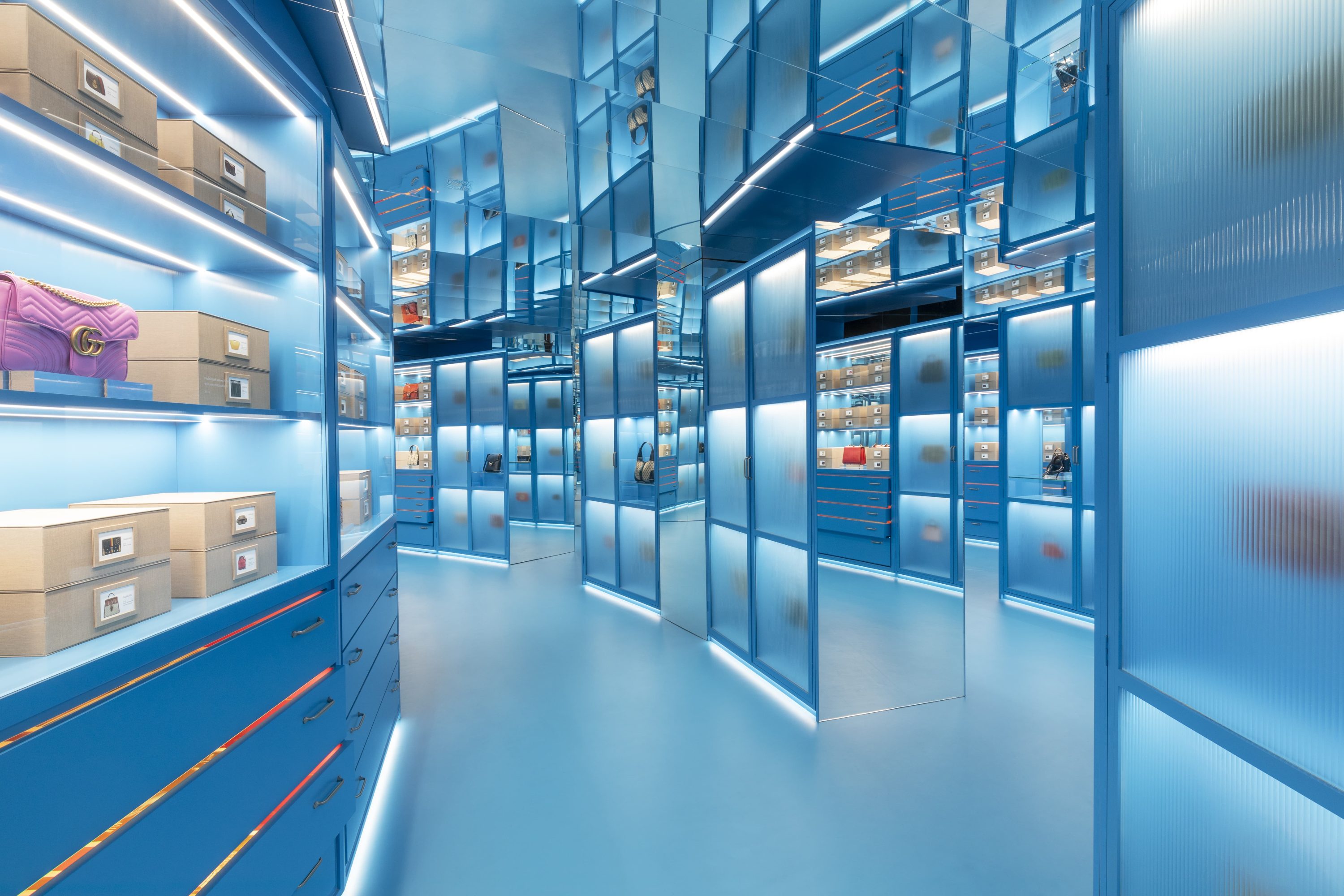
To Infinity and Beyond
Taking a tour of the exhibition during the press preview, installations created to immerse the viewer through all five senses were developed by contemporary artist and stage designer Es Devlin, who is known for creating large-scale performative environments, most recently for Beyonce’s Renaissance world tour and Saint Laurent’s men’s show in the Agafay desert in Morocco, as well as work for the Tate Modern, V&A museum, and the Royal Opera House. Devlin also included a number of elements including a reproduction of The Savoy Hotel’s Lobby which was specifically included as a way to pay tribute to the exhibitions current host city. A city which is a key part of Gucci’s story, as it is well-documented that London was where the brands founder Guccio Gucci became inspired to start the house, first with luggage then apparel, after spending time as a porter at The Savoy hotel.
As an innovative way to convey the Houses’ unique 102-year narrative, Italian professor, curator, and critic Maria Luisa Frisa was selected by the House to curate their “era-defining designs” for the exhibition and has included a number of items borrowed from the Gucci Archive in Florence – another link to Gucci’s centenary, as it was also opened in 2021.
Organised across nine unique rooms – eschewing chronological or creative director order – visitors will have the opportunity to discover for themselves “an immersive expository experience in which the origin story and history itself are continuously put to the test by the imagination of the future” according to the brand.
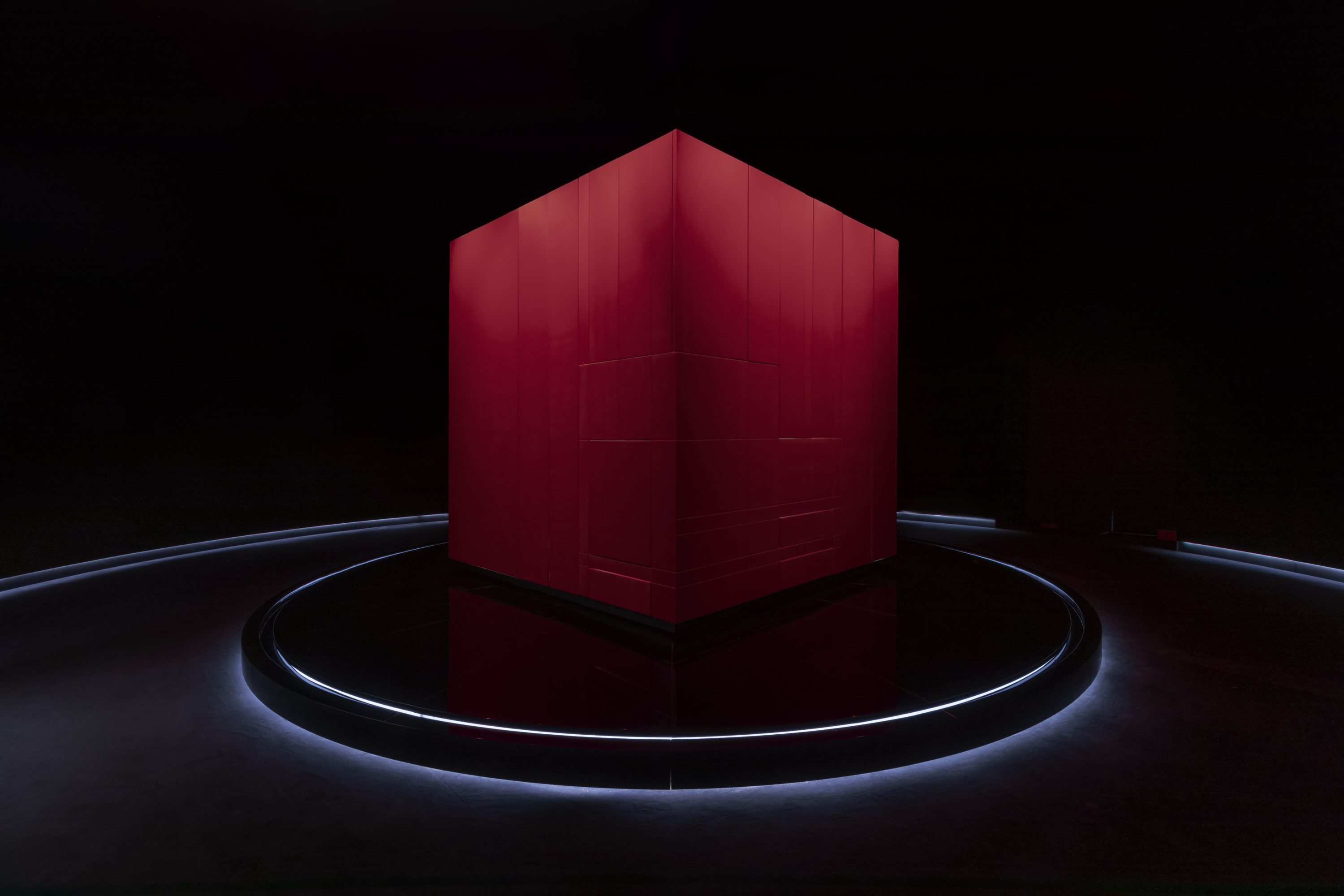
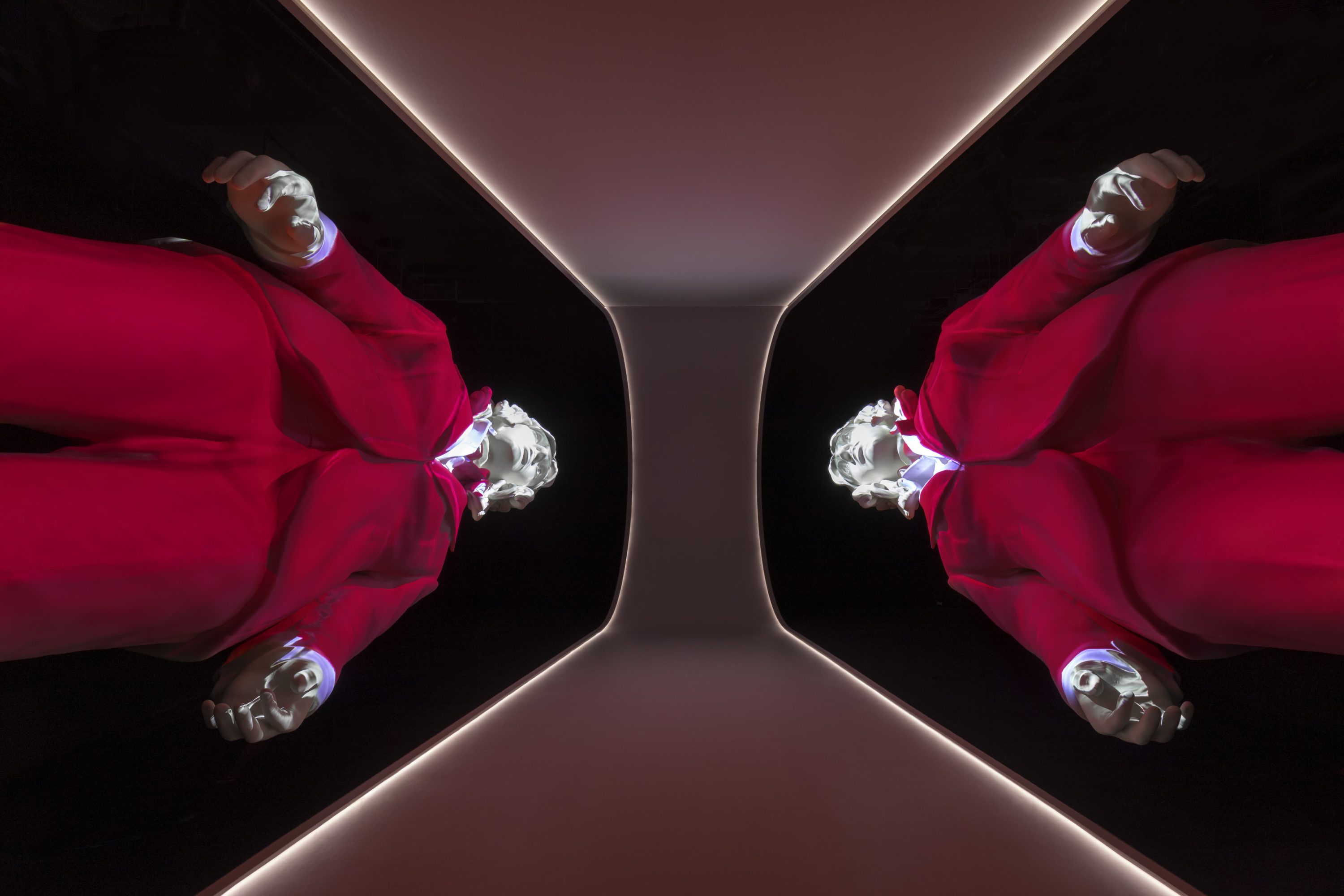
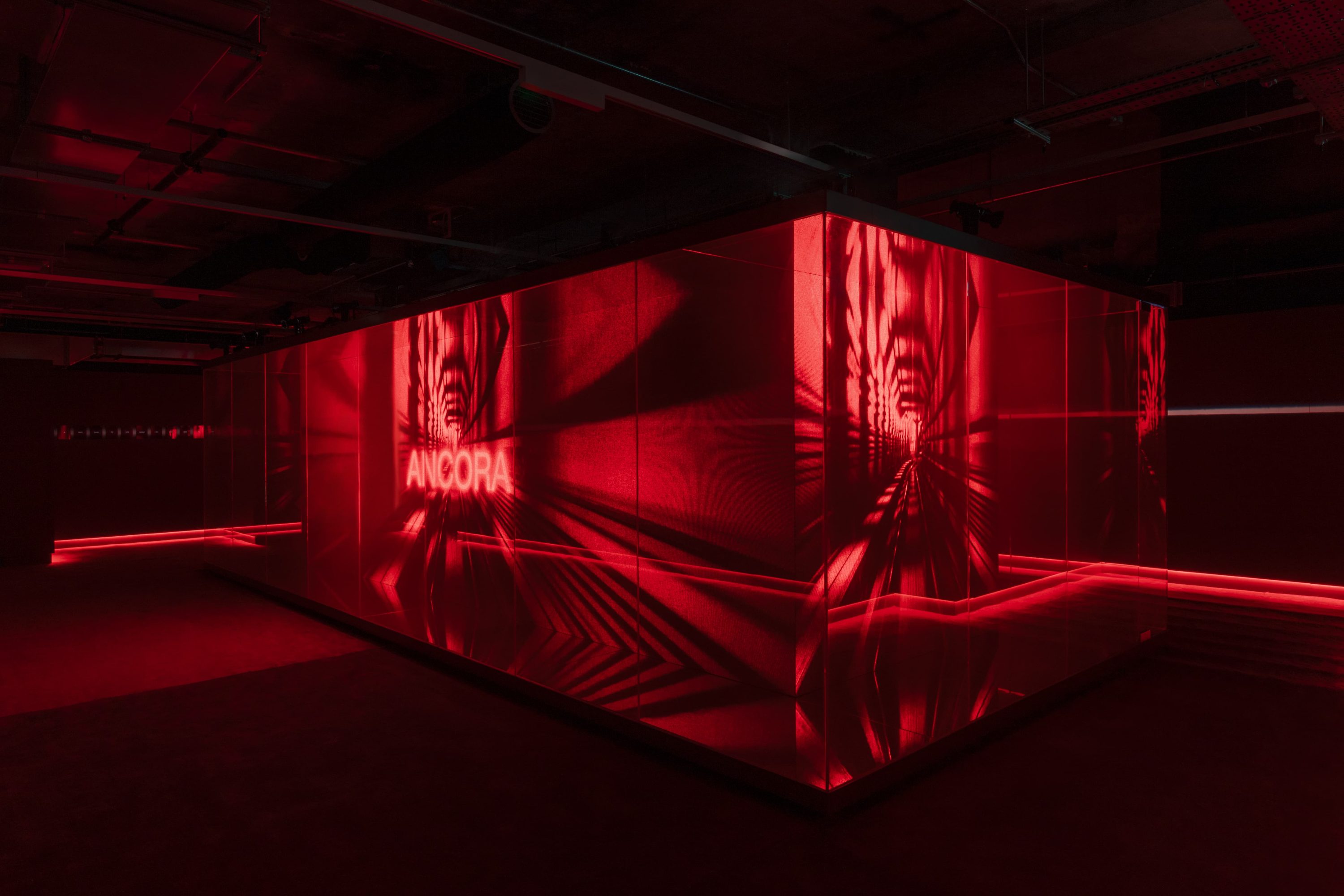
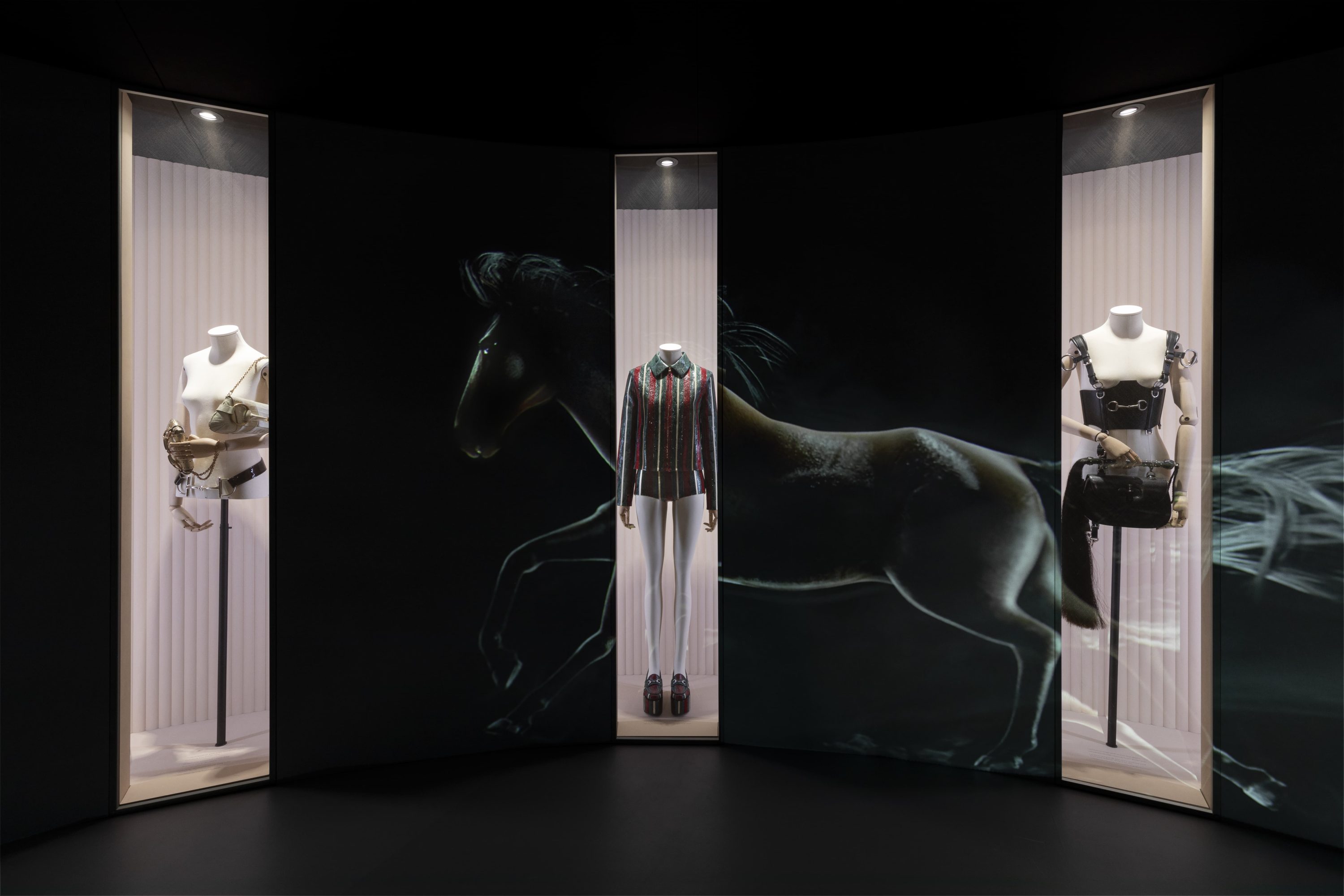
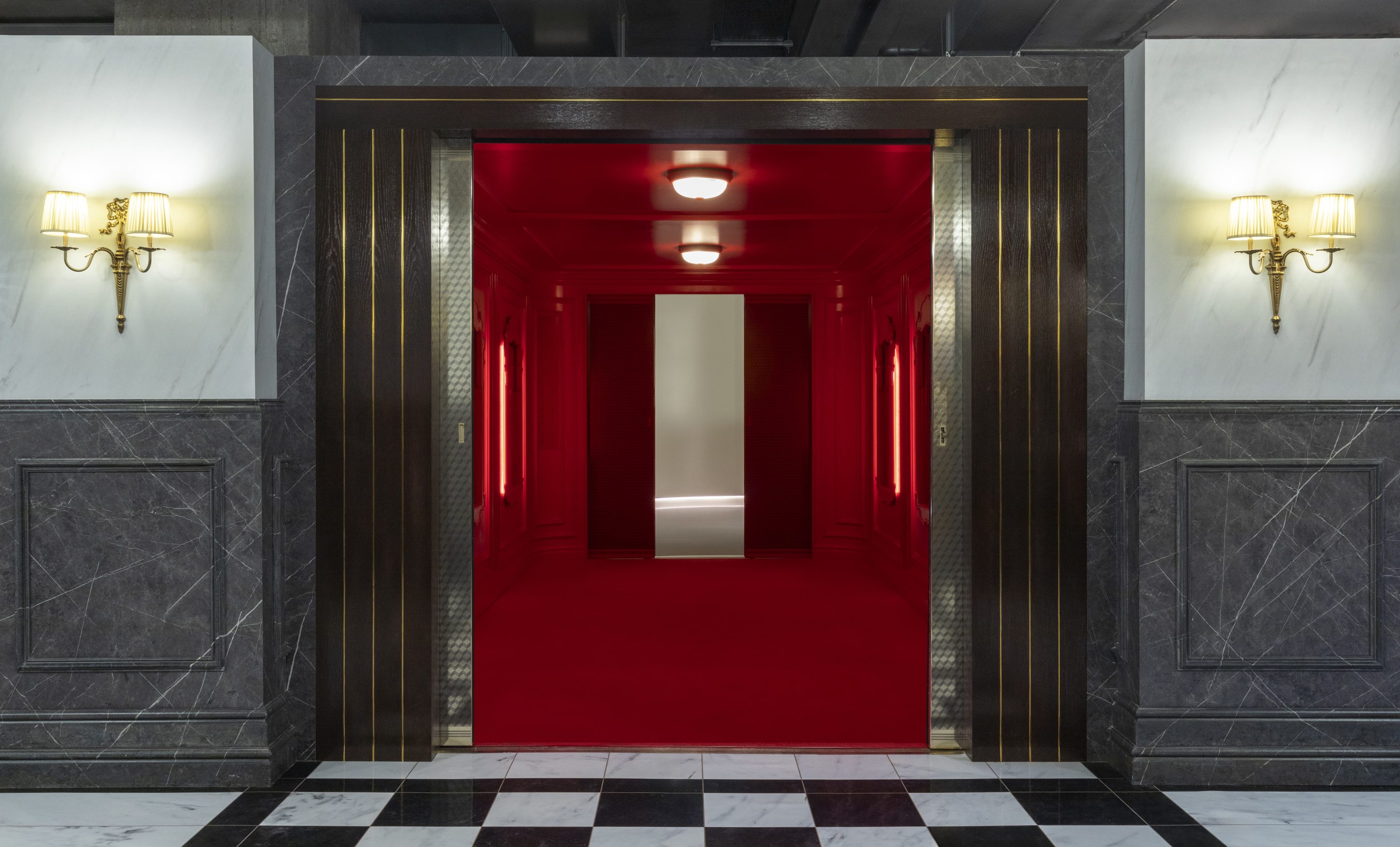
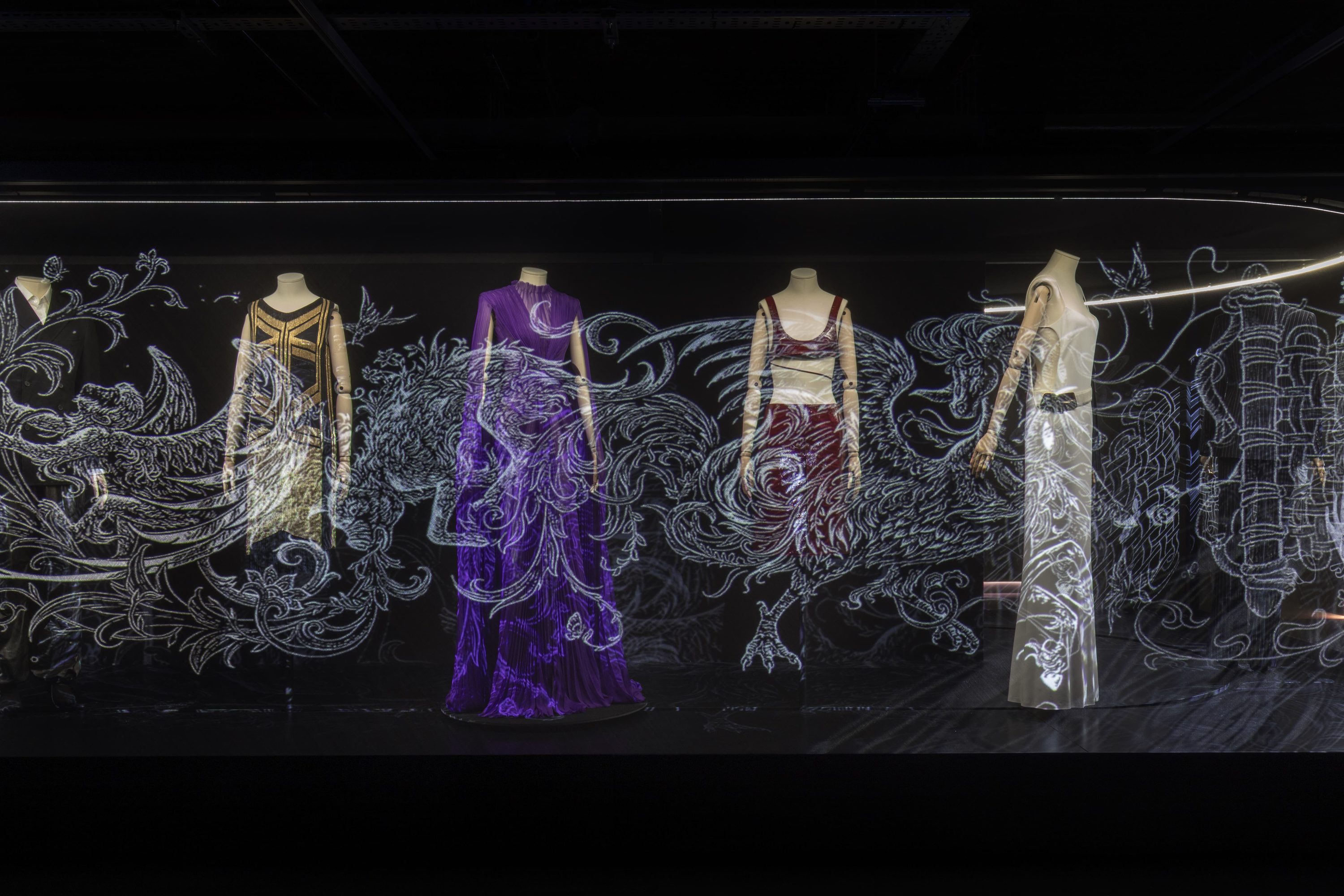
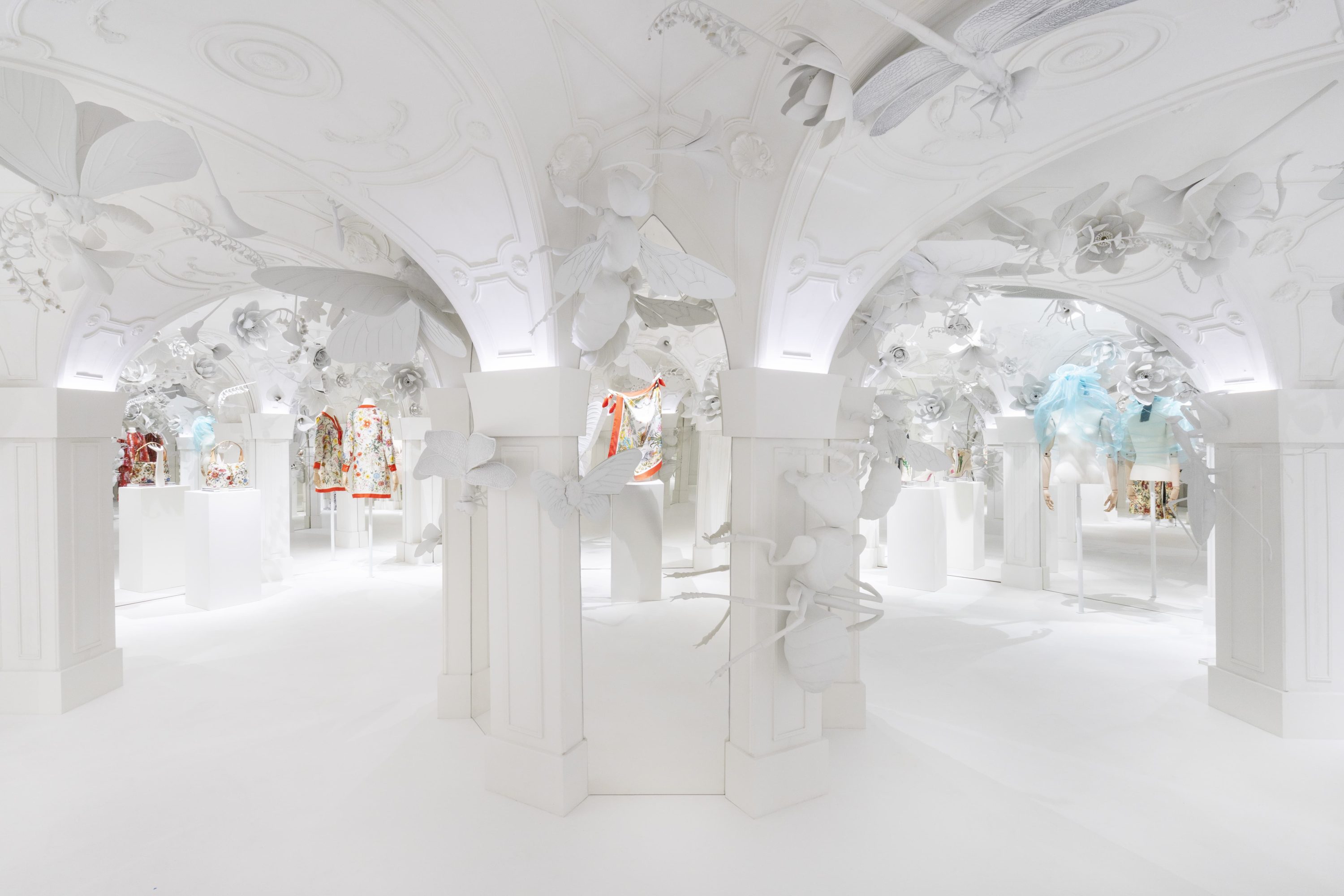
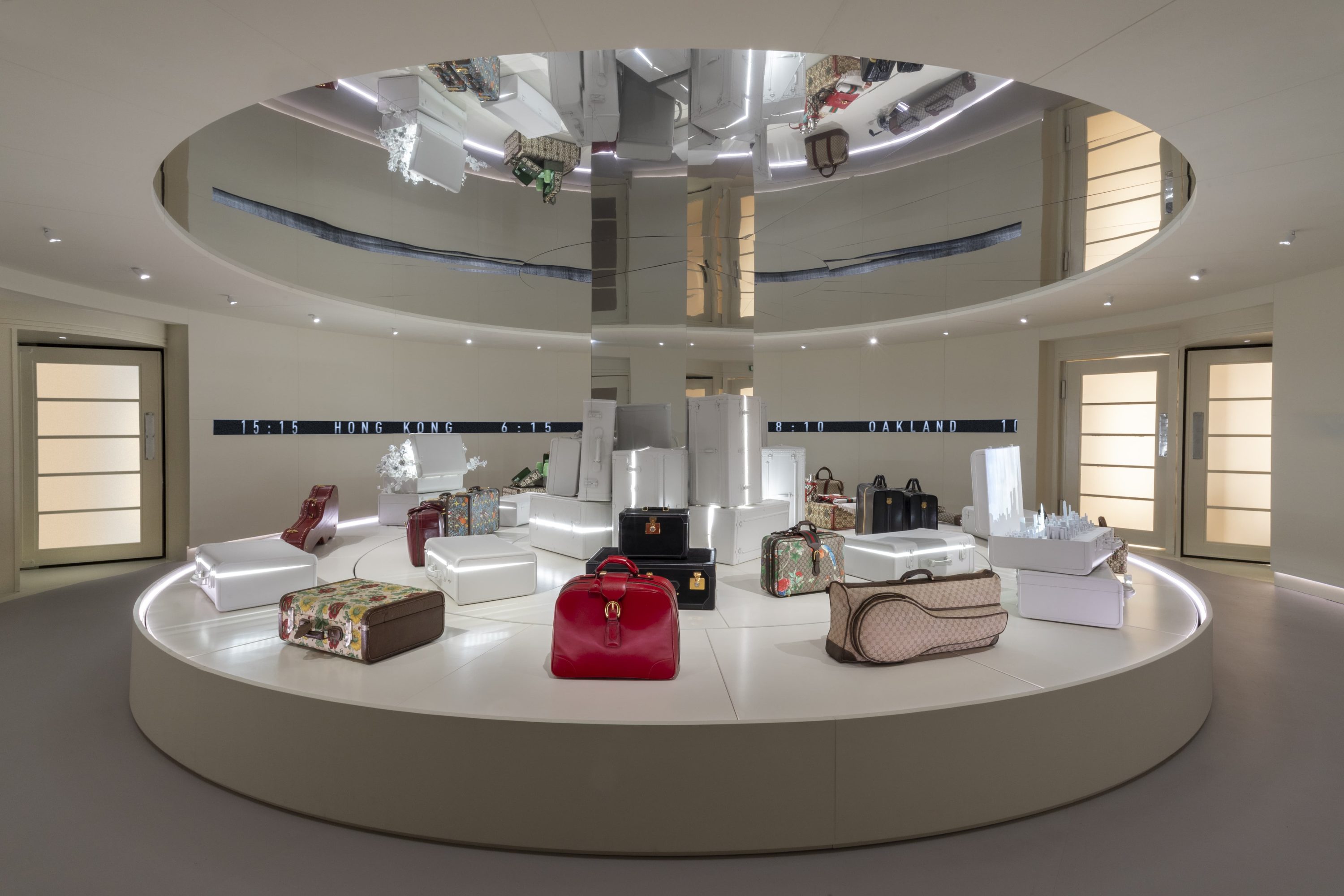
THE ASCENDING ROOM
It is not often that old-school magic tricks are utilised by brands to wow their audience, especially not at a time when AR technology is readily available at your fingertips. But upon entering the exhibition visitors are treated to a replica of the Savoy Hotel lobby complete with chequerboard floor and ‘working’ elevator, in homage to Guccio Gucci’s humble beginnings as a porter and the place where the idea of the Gucci brand was birthed.
Step inside the first of many immersions created by Es Devlin, and you are immediately enveloped inside the colour red. Which was chosen for its connection to the brand and also the heart, as an emotional gesture. As guests wondered how they would be transported through several floors of an exhibition which was only set across three, the traditional element of magic – reminiscent of Charlie and The Chocolate Factory – kicked in as the mirrors (which were actually video screens) came to life and a “son-et-lumière (sound and light show)” took passengers on a seven-minute ascending journey, the same as the original guests would have experienced in 1889.
We chose this deep red long before Sabato (De Sarno) had come up with this beautiful Ancora Red colour, we had just chosen it, deriving from the (Savoy Hotel) lift and from the heart, which is what I think informed Sabato’s choice. And when you walk into that revolving red box (Cabinet of Wonders room), I hope you feel an exchange of heart, love, emotion, even before we look at the exquisite objects that are being revealed”
Es Devlin, Exhibition Concept and Design, Gucci Cosmos
PORTALS
Stepping out into another dimension, or Portal if you will, luggage takes centre stage and aligns with their most recent campaigns starring Ryan Gosling and model Kendall Jenner and Bad Bunny, to showcase the heritage of Gucci Valigeria (which translates to leather goods store), and its most recent iteration in their ‘Savoy’ collection, harking back once again to the founders roots in the city.
Observing the many types and variations of luggage by end-use rotating around the carousel – meant to resemble that of the airport carousel, albeit a very luxe one – there is an innate understanding of how the brand could penetrate all corners of a consumers lifestyle. On display were GG canvas tennis bags from the 1970s and full picnic sets from as early as the 1950s, to guitar and vanity cases.
A HALL OF HISTORY
A humbly decorated hallway connects visitors to the brands timeline thus far. Picking up on its ‘Beginnings’ in 1921 inspired by international high society and their luggage, through to the introduction of House materials such as ‘Bamboo’ in 1947, the unique ‘Flora’ design of 1966, and the names who have helmed the brand, reflecting the times and in many instances shifting the zeitgeist – from Tom Ford, to Frida Giannini, Alessandro Michele, and now Sabato De Sarno.
ZOETROPE
The history of photographer Eadweard Muybridge’s pioneering device is well-documented, as through the use of 12 cameras to sequentially capture a galloping horse, which was then rotated at speed imitating movement to trick the human eye fused the aforementioned old-school magic with its technological counterpart.
The ‘Zoetrope’ room takes the idea of the first motion picture device and used its first subject – the horse – through which to tell the story of the brands long-standing associations with the equestrian, from horsebit loafers to riding boots and hats, as well as harnesses re-imagined as a leather bustiers from the fall 2021 collection.
EDEN
A purposely all-white room, created as a “new garden of Eden” and to amplify the pieces on display, this room tells the history of Gucci’s affinity with the Flora motif. Which has been reinterpreted in one way or another during each creative directors tenure. In particular Frida Gianninis embellished Jackie Bag, Tom Fords psychedelic men’s cotton pants from summer 1999, and Alessandro Michele’s embroidered denim jacket from his fall 2016 collection. The room is also a recognition of the origins of the bespoke scarf created for Princess Grace of Monaco by Italian illustrator Vittorio Accornero de Testa after a visit to the Gucci boutique in Milan. Featuring 43 varieties of flowers, plants and insects in its hand-painted design.
TWO
As an introduction to the second part of the exhibition and a tangible link to its title, guests are invited into the ‘Cosmos’, as they are reminded by a voice-over that “There is a Cosmos in you”. The room features two lying figures who, according to the brand “recall the novel Gulliver’s Travels” but in this time and space their purpose was to act as a canvas, as projections of suits from both the men’s and women’s collections were transferred onto the two giants, in an exercise in gender-duality, and a reference to today’s filter-obsessed technology as a way to redefine ourselves.
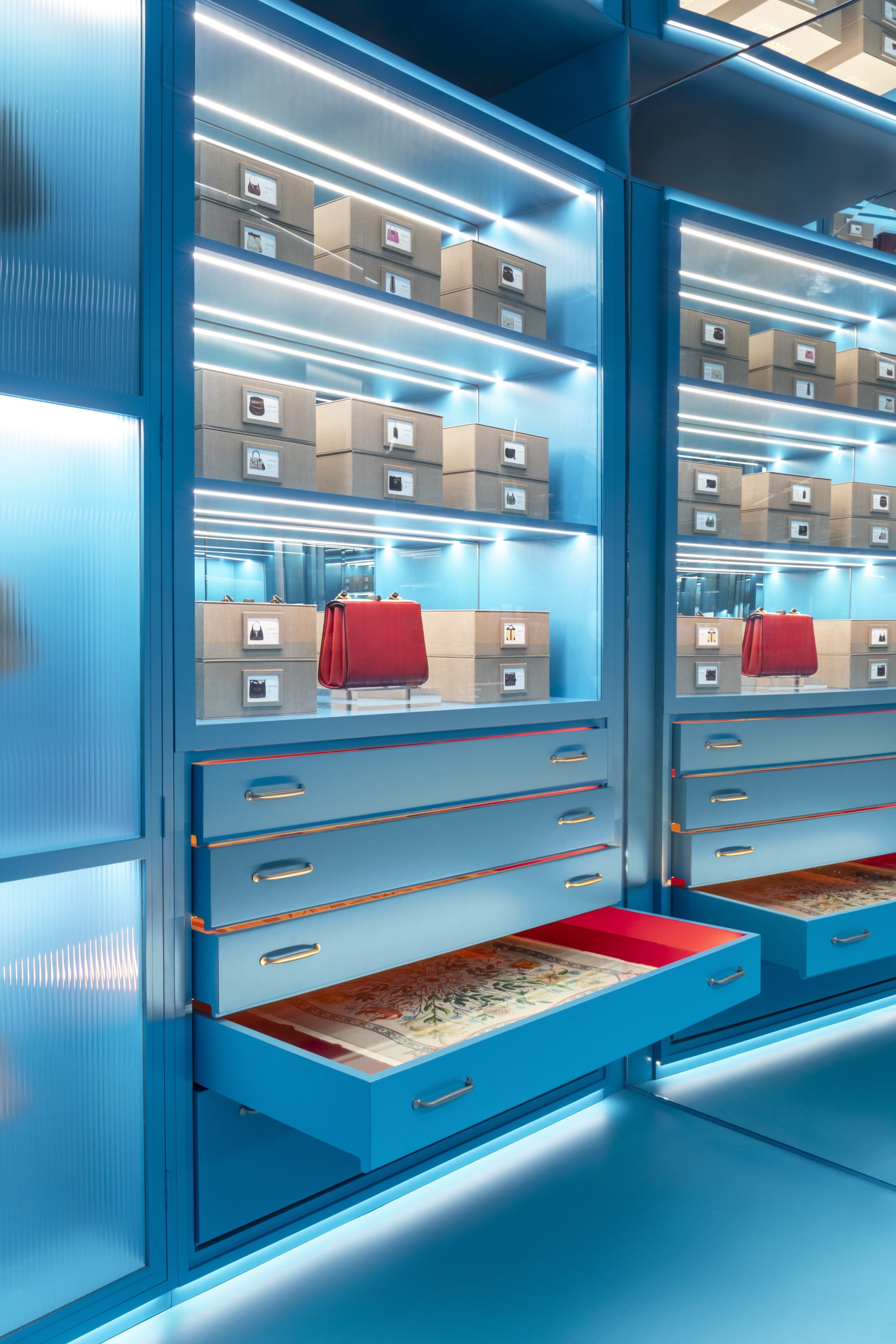
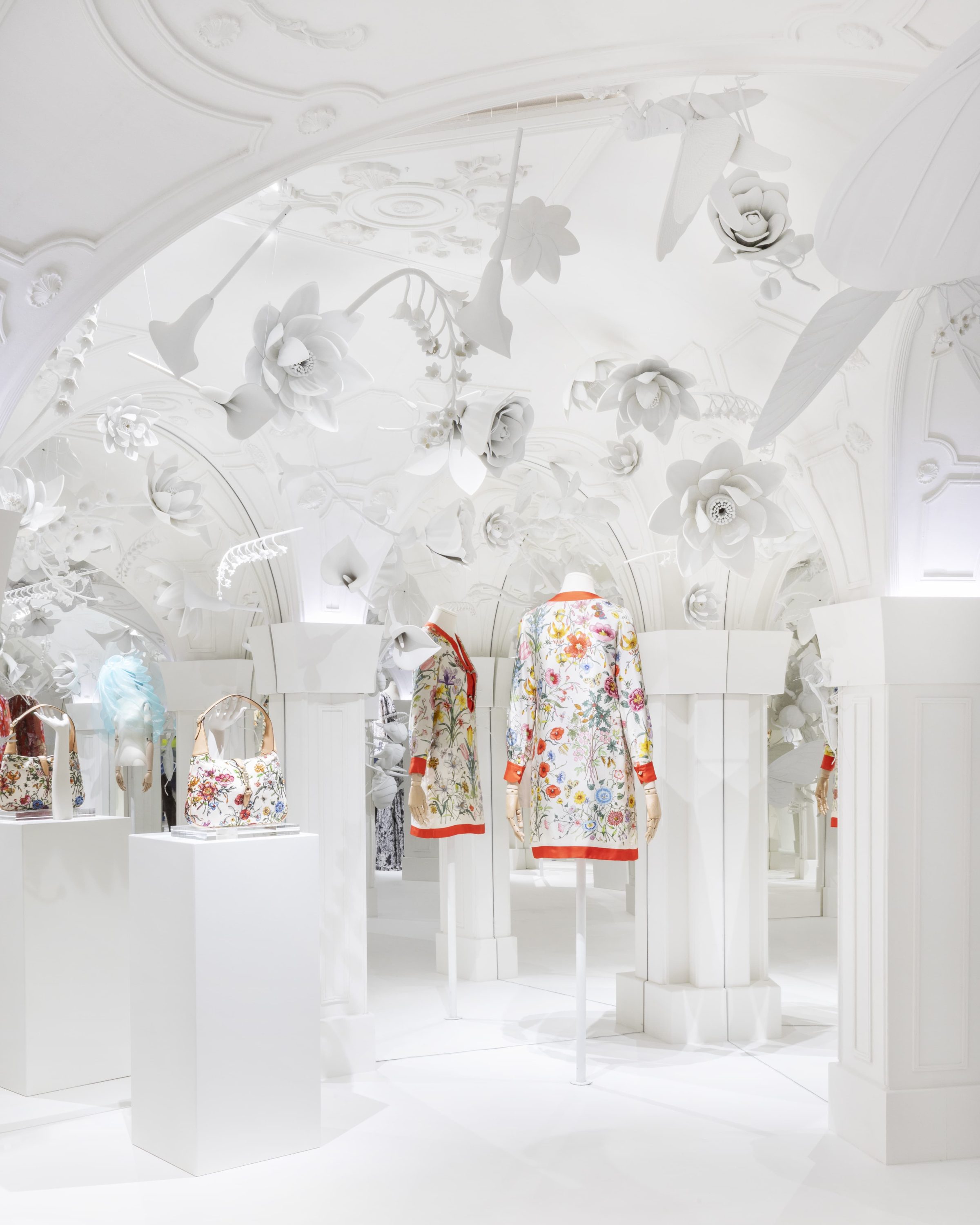
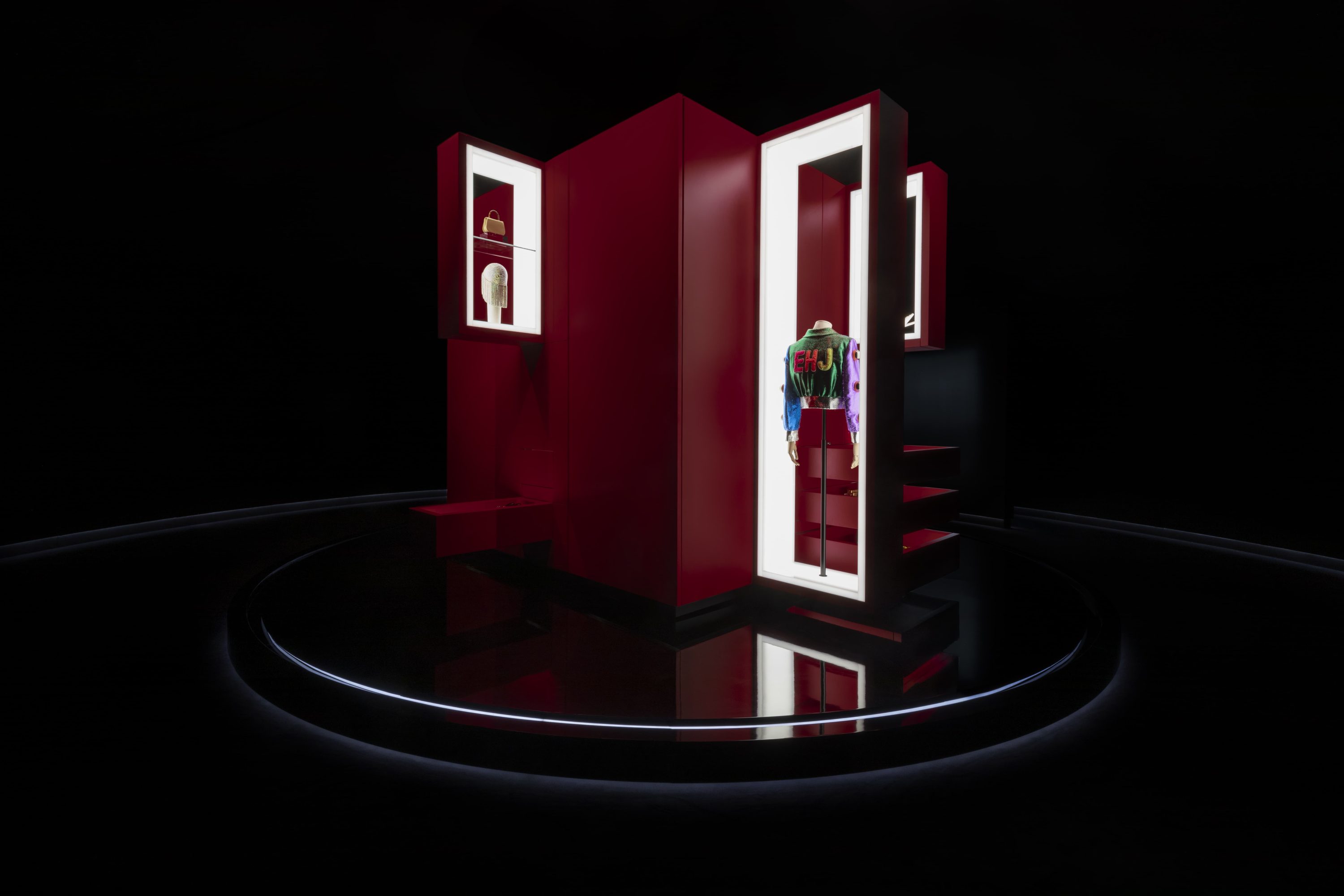
(On visiting the Gucci Archive in Florence) It was like entering a maze of multiple imaginations through time, starting 100 years ago and passing the creative baton, from one energy, one human, one designer to the next over the years, and in this house you find objects that speak to you, and my practice in theatre has led me to trust that an object can speak, can have a voice, and that for me was the jumping off point [for this exhibition], that visit to the archive.”
Es Devlin, Exhibition Concept and Design, Gucci Cosmos
ARCHIVIO
A small piece of the Gucci Archive which is travelling with the exhibition, recalls that of the Houses’ Florence archive at the Palazzo Settimanni on Via delle Caldaie. Here the archive is a reminder that it is a living, breathing resource, which not only conserves Gucci’s brand history – from creative processes, manufacturing procedures, image-making, and final product – but it also affects each designer, artisan, and intern who passes through it. Constructed like a labyrinth with multiple mirrors from floor-to-ceiling, glass walls, and drawers of discovery, the room demonstrates how the ‘Archivio’ is creating new pathways of creativity for all who visit it.
The Gucci bag, as both inspiration and icon has been encoded in the brands DNA and leads the exploration of the room. From mini bamboo backpacks from the 1990s to leather ‘Jackie’ bags from the 1970s, to the horsebit chain bag of the early 2000s, the GG Marmont bag, and exclusive pieces from the most recent Gucci Ancora runway show.
Gucci Cosmos…was an extraordinary opportunity for me to traverse the universe of Gucci. And I was able to tell its story through the clothes, objects, elements, people, and contexts that made this brand iconic and a trailblazer within fashion and collective visual culture for over a century.”
Maria Luisa Frisa, Curator, Gucci Cosmos
CABINET OF WONDERS
This all-black space (that serves as a balm to quiet the senses from the previous rooms) is occupied only by a glossy red rotating trunk, or cabinet, housing a Gucci wardrobe of dreams, and playing on the notion of admiring the closets of celebrities from the ‘Golden Age’ of Hollywood to present day. As each drawer or door opens consecutively, a new ‘Wonder’ is revealed as artefacts from the past are preserved for the future. With each piece exuding a personality, viewers can marvel and recall the Coachella performance of Harry Styles in a sequinned jumpsuit, or the custom-made velvet dress worn by Irish disability activist Sinead Burke at the Met Gala in 2019.
The cabinet also represents the way in which clothes aren’t made just to be exhibited or preserved, but to be worn, which in turn create stories of self-expression, activism, or unbridled joy, holding memories of the past, present, and future.
CAROUSEL
The perpetual motion of the 25 looks on display as part of a carousel, portrays Gucci’s designs as they will so often be first viewed, on the runway and in motion. Not adhering to a particular collection or season, each look is reflective of the time in which it was debuted, and communicates the way the House has maintained its desirability as a key luxury player through constant evolution and a focus on creativity.
Displayed side-by-side “colour and inspiration” dictated their position in the line-up by the various creative directors who made their mark on the House. The conveyor belt ‘runway’ highlights looks worn by Lady Gaga for the premiere of House of Gucci, and the now infamous red velvet unisex suits designed by Tom Ford in 1996.
Housed behind a mesh screen, a projection features illustrations by artists from the first stop of the exhibition in Shanghai, with the artistic thread being continued through the commissioning of four UK-based artists who have added their creative vision which serves to strengthen the “creative ties across continents” according to the brand.
GUCCI ANCORA
The end of the exhibition also marks the beginning of a new chapter for the House, with a space inspired by the new creative director Sabato De Sarno. The Gucci Ancora room, sans clothes from De Sarno’s first collection, is a deeply visceral space, decorated from floor-to-ceiling in the new signature shade of red ‘Rosso Ancora’. It is a space which is dedicated to personal memories and fragments of conversations had between De Sarno and Es Devlin when conceiving the room. Bordering the room in single semi-transparent squares hung on the wall (each printed with one word) is his manifesto, which is “a story of joy of life, of passion, of humanity, of people, of real life, of irreverent glamour, of provocation, of confidence, of simplicity, of immediate feelings and emotions”. And as each square can be moved at the will of the viewer, the manifesto will become an ever-changing composite of the Gucci Cosmos London.
The Ancora Room is an immersion into colour and emotion. Sabato and I did an interview together asking each other questions about poetry, love, and what’s most important to us. We show our radical vulnerability in it, and it’s very personal to us. And that’s a new final room [of the London exhibition]”
Es Devlin, Exhibition Concept and Design, Gucci Cosmos
At a time of top-down change for the luxury House and following the debut of its current creative director Sabato De Sarno during Milan fashion week, the focus on the brands storied heritage will continue to re-clarify their luxury status as they embark on this new chapter with history, the power of creativity, and profound storytelling at the forefront.
